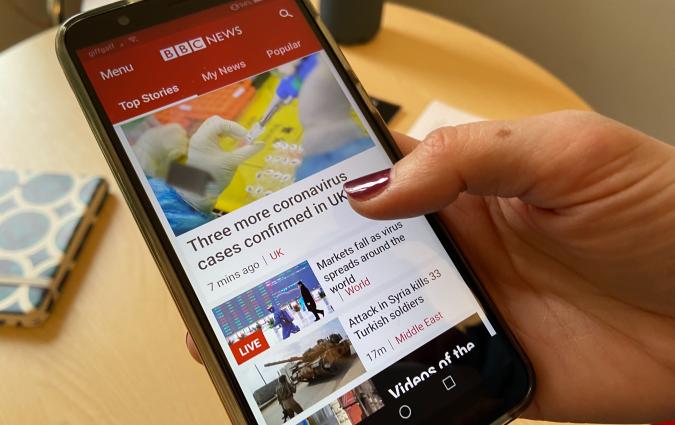How RFE/RL avoids censorship by reaching audiences on Telegram in Russia and Iran

Alina Živanović.
Italian journalist Francesco Zaffarano has recently launched a biweekly Substack newsletter, Mapping journalism on social platforms, featuring interviews with people leading news innovation on social media. Here's the latest interview he published, lightly edited for brevity and clarity. The original is available at this link. Sign up for the newsletter here.
I spoke with Alina Živanović, the digital strategy manager responsible for social media at Radio Free Europe/Radio Liberty. RFE/RL is a US government-funded non-profit organisation that covers news in 23 countries and 27 languages. Alina works with their newsrooms on distributing content on social media platforms in every country where RFE/RL is active, managing accounts on various platforms, and establishing and sharing production and distribution best practices.
“We try to meet our audiences where they are. In many places, largely due to significant state censorship, this is Telegram,” Alina told me. RFE/RL counts more than 30 Telegram channels to share their reporting in closed media spaces, including Russia and Iran.
Q. What is the rationale behind the launch of a new channel?
A. The rationale in RFE/RL’s markets is two-fold: building dedicated subscription offerings and gathering audience input.
Our standard rollout process for new channels starts with defining our audiences, their informational needs, and a plan for best meeting them.
RFE/RL’s rollout process also includes a competitive review to see what other outlets in the market are doing. This process sometimes makes it clear that a Telegram channel is not the answer to our publishing plans. But sometimes Telegram is the perfect answer. Our experience shows that it is particularly useful when major news breaks, like Russia’s war in Ukraine, and with a dedicated audience with shared information needs that we can access directly.
Q. How is Telegram different from the other platforms?
A. Telegram can be powerful because of its dual nature: it serves both as a direct messaging service and as a broadcasting tool; users can communicate with each other and subscribe to channels and large private groups.
Telegram is very easy to use for publishing. The browser and mobile app both have multiple editing options and direct posting. It’s also easy to schedule and create polls and host audio or video streams. It’s a great platform to get information and feedback from the audience. RFE/RL frequently uses it to crowdsource information.
Telegram can also be a good indicator of news fatigue. No matter how often we publish, we can’t provide enough content during big news moments. But when news fatigue sets in, or the moment subsides, people mute or leave the channels. When this happens, we adjust workflows and adopt a “less is more” approach.
Q. How does Telegram fit into RFE/RL strategy and goals?
A. At RFE/RL, we consider Telegram channels subscription offerings like newsletters. They aren’t great for discovery because we don’t benefit from algorithmic amplification. Our audience growth is largely driven by user recommendations, meaning we must offer content people want to share.
Critically, Telegram is unblocked in countries like Russia, where other social media platforms and websites are strictly censored. While we use various tools to circumvent censorship on other platforms, the open availability of Telegram for users makes it an important component of how we reach audiences – particularly new audiences – and counter disinformation.
While RFE/RL operates in difficult media climates, like all news organisations, we only stand a chance to reach our audiences by being immediately interesting and relevant. Otherwise, people will unsubscribe or mute. When our reporting is at its best, Telegram gives us a great way to build community and stay connected with loyal users who build habits around our offering.
Q. How many people work on RFE/RL Telegram channels? What do they do?
A. Each of RFE/RL’s 23 services approaches Telegram differently depending on the platform's role in the local context. From two to 20 journalists in each service contribute to publishing, editing, reposting, scheduling posts, and gathering community input. In some teams, we have individual colleagues running the channel. In others, it’s a task shared by the team.
Q. Do you produce content specifically for Telegram channels?
A. We adapt content for Telegram but usually don’t specifically create content. There are exceptions, though. During Russian drone attacks on Ukraine, Tetiana Savchuk, senior social media editor with the Ukrainian service, shared how the service created graphics for its Telegram channel with instructions on identifying an attack and staying safe. The idea was that followers could download the image and reshare it in other messaging channels with family and friends or post it on stories on social media.
RFE/RL is also experimenting with briefing formats that don’t require clicking links to get more information. In locations like Iran we natively upload video or audio files, which can be useful when communities are exposed to internet connectivity outages. In the Donbas region, our regional project Donbas.Realii published daily summaries of the war situation in a series called The Battle for Donbas.
At the Russian Service, Radio Svoboda, we have a dedicated podcast channel for audio files, a reflection of Radio Svoboda’s strength in this format. We carry short summaries of podcasts, as well as pull quotes and the full audio files. We also try to understand our audience’s behavioural habits and format preferences, so we carry out questionnaires and surveys.
We have also experimented with live audio and video streaming, but neither has caught on. In countries where RFE/RL is blocked, we use so-called mirror links to ensure people can access the links despite government bans on our sites.
Q. What are your most popular channels, and what is their reach?
A. The most popular RFE/RL Telegram channel is of Current Time, a 24/7 TV and digital network for Russian-language speakers worldwide. It has more than 220k subscribers, and each post reaches more than 44k accounts on average.
Next is the Russian Service’s channel Radio Svoboda, with 116k subscribers, and the Persian-language service’s channel Radio Farda, with nearly 113k subscribers.
Q. How much traffic to your website comes from Telegram?
A. Only 1% of RFE/RL’s website traffic comes from Telegram, but this is not what we use the platform for in our markets. We often publish on Telegram without any links to the website. We are interested in building a community on the platform.
Q. What metrics do you use to analyse your content performance and why?
A. We check overall subscriber numbers on RFE/RL channels monthly. Daily, we keep track of reactions, engagement, video views, and audio plays. TGStat is a great resource for advanced analytics.
Q. What is one thing you would like to change on Telegram?
A. Two things: improve security and better platform-native metrics.
If you want to know more...
- Find all RFE/RL channels on Telegram listed in the Telegram tab of Francesco’s Mapping Journalism spreadsheet.
- Read about Telegram’s growth and how it compares to other social networks and messaging platforms in our latest Digital News Report.
- Read this piece on NiemanLab about how Telegram became the go-to app for Ukrainians after the outbreak of war.
- Follow our own Telegram channel.
Francesco Zaffarano is an experienced Italian digital journalist, currently working as senior audience editor at global development platform Devex. Before this, he was editor-in-chief of Italian social media-first outlet Will Media and has covered a range of roles in social media and audience engagement for several Italian and UK newspapers. Zaffarano has recently launched a biweekly Substack newsletter, ‘Mapping journalism on social platforms’, featuring interviews with people leading news innovation on social media. The original interview is available at this link. Sign up for the newsletter here.
In every email we send you'll find original reporting, evidence-based insights, online seminars and readings curated from 100s of sources - all in 5 minutes.
- Twice a week
- More than 20,000 people receive it
- Unsubscribe any time







